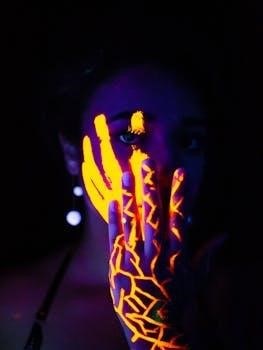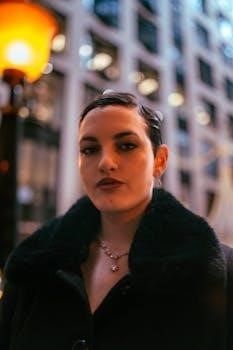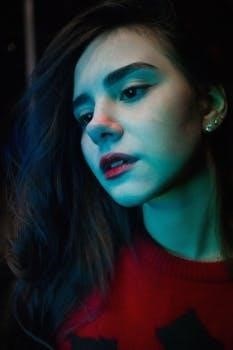
The Night Face Up⁚ A Detailed Article Plan
This article will explore Julio Cortázar’s “The Night Face Up,” analyzing its plot, characters, and themes. We will delve into the symbolism and narrative structure, examining the blend of realism and surrealism. Cultural context, particularly Aztec beliefs, and Cortázar’s literary style will also be discussed, providing a comprehensive analysis.
Julio Cortázar’s “The Night Face Up,” originally published in his collection Bestiario, is a compelling short story that masterfully blends elements of realism, fantasy, and surrealism, a hallmark of his distinctive writing style. This narrative delves into the psychological and philosophical implications of the dream world, challenging the reader’s perception of reality. The story presents a dual narrative, alternating between the experiences of a modern man and an ancient Aztec captive, creating a metaphysical exploration of time and consciousness. Cortázar’s narrative invites the reader into a world where the boundaries between the real and the imagined blur, leaving a lasting impression. This exploration of alternate realities, coupled with vivid sensory imagery, effectively reveals the protagonist’s terror and lack of control. The tale is a thought-provoking journey through time and space, raising fundamental questions about existence and our understanding of the world around us. “The Night Face Up” is a testament to Cortázar’s ability to craft a rich and immersive narrative that lingers long after the final page;
Plot Summary of “The Night Face Up”
The narrative of “The Night Face Up” begins with a modern-day man riding his motorcycle in Buenos Aires. After a sudden accident, he is taken to a hospital, where he drifts in and out of consciousness. As he recovers, he experiences vivid and disturbing dreams that transport him to an ancient world. In these dreams, he is a member of an indigenous tribe, hunted by Aztec warriors for sacrifice. The story alternates between his hospital experiences and his nightmarish reality as a captive, creating a disorienting and suspenseful effect. The protagonist struggles to distinguish between his present-day reality and his dream state, as the two worlds begin to merge. The hospital becomes a terrifying space where he is surrounded by familiar sounds and smells, which are also present in his dreams. Ultimately, the two realities converge, and the protagonist is captured and sacrificed in the ancient world, revealing that his modern life was the dream. The story’s conclusion leaves the reader questioning the true nature of reality and consciousness, emphasizing the cyclical nature of existence. The narrative highlights the terrifying transition between two very different worlds, leaving a lasting impression on the reader.
Character Analysis⁚ The Protagonist’s Dual Existence

The protagonist of “The Night Face Up” embodies a fascinating duality, existing simultaneously as a modern man and an ancient Aztec captive. In his modern life, he is a young man living in Buenos Aires, experiencing the everyday routine of city life, and enjoying the freedom of riding a motorcycle. However, this persona is abruptly disrupted by the motorcycle accident, which plunges him into a terrifying alternate reality. As an Aztec captive, he experiences a primal existence, hunted and fearful, facing imminent sacrifice. This dual existence is not merely a contrast of different eras, but also a study in contrasting states of consciousness. The protagonist struggles to discern which reality is genuine, blurring the lines between his waking life and his dreams. His emotional state oscillates between the mundane concerns of his modern life and the raw terror of his Aztec captivity. This constant shift between the two worlds creates a sense of disorientation and vulnerability, revealing the protagonist’s fragile hold on reality; His journey underscores the precarious nature of identity and the unsettling possibility that what we perceive as real may be an illusion. Ultimately, the protagonist’s experience is a profound exploration of the human condition.
Themes Explored⁚ Reality vs. Dreams
A central theme in “The Night Face Up” is the exploration of the blurred boundaries between reality and dreams. The narrative masterfully intertwines the protagonist’s experiences in a modern hospital setting with his terrifying visions of being an Aztec captive. This constant oscillation between two distinct realities challenges the reader’s perception of what is real and what is imagined. The protagonist’s struggle to distinguish between his waking life and his dreams highlights the subjective nature of experience. The vividness and intensity of both realities make it increasingly difficult for him, and the reader, to discern which world is genuine. The story suggests that reality is not a fixed entity, but rather a construct that is shaped by our perceptions and experiences. Cortázar cleverly uses the dream state to explore deeper psychological and philosophical questions, blurring the lines between the conscious and the subconscious. The narrative reveals that dreams can be just as powerful and impactful as waking experiences, raising questions about the nature of consciousness and the stability of our perceived reality. Ultimately, “The Night Face Up” invites us to question the very fabric of our own existence and the nature of truth.
Themes Explored⁚ Fate and Predestination
The theme of fate and predestination is a significant element in “The Night Face Up,” adding a layer of complexity to the narrative. The protagonist’s seemingly random motorcycle accident is not presented as a mere coincidence but rather as a predetermined event that sets the stage for his descent into a terrifying alternate reality. This idea of a preordained path is further emphasized by the protagonist’s inability to escape his destiny in the Aztec dream world. Despite his efforts to resist capture and sacrifice, he is ultimately powerless against the forces that seem to guide him towards his inevitable fate. The story suggests a sense of helplessness against a higher power, where individual actions appear to have little impact on the grand scheme of things. Cortázar uses the juxtaposition of the modern and ancient worlds to highlight the universality of this theme, suggesting that humans across time have grappled with the notion of predetermined destiny. The narrative invites the reader to consider whether our lives are truly our own or if we are merely puppets of fate. This exploration of predestination raises profound questions about free will, choice, and the limits of human agency, leaving the reader contemplating the extent to which we control our own lives.
Symbolism in “The Night Face Up”⁚ The Motorcycle and the Hospital
In “The Night Face Up,” the motorcycle and the hospital are potent symbols that enrich the narrative’s thematic depth. The motorcycle, initially a symbol of freedom and modernity, becomes the catalyst for the protagonist’s journey into the surreal. It represents his detachment from the mundane and his entry into a liminal space where the boundaries of reality blur. This transition from freedom to confinement mirrors the story’s overall exploration of fate and the protagonist’s loss of control. Conversely, the hospital serves as a symbol of the liminal space between life and death, and reality and dream. It is a place of supposed healing and safety, yet it becomes the gateway to the protagonist’s terrifying alternate reality. The sterile environment contrasts sharply with the primal horror of the Aztec world, highlighting the instability of the protagonist’s perceptions. The hospital represents the fragility of the modern world’s attempt to control and understand the inexplicable, while the motorcycle represents a journey that ironically ends in confinement. These symbols collectively underscore the story’s exploration of the tenuous nature of reality and the thin veil between the conscious and subconscious.
The Role of Dreams and Nightmares in the Narrative

In Julio Cortázar’s “The Night Face Up,” dreams and nightmares are not merely passive experiences but rather active forces that drive the narrative and blur the lines between reality and illusion. The protagonist’s journey through the story is marked by a constant oscillation between his waking life in a modern hospital and his vivid, terrifying dreams of being a Motecan Indian pursued by Aztecs. These dreams are not simple reflections of his subconscious fears; instead, they serve as a portal to another time and reality, revealing a profound connection between his present and a distant past. The nightmares escalate in intensity, becoming increasingly real and visceral, until they ultimately overshadow the “real” world, leading to a chilling revelation about the protagonist’s true identity. Cortázar uses the dream sequences to challenge the reader’s perception of reality, questioning the very nature of consciousness and the boundaries of time. These unsettling visions are not mere fantasies but pivotal elements that reveal the protagonist’s true fate, highlighting the power of the subconscious to shape and even dictate reality. The blurring of dreams and nightmares makes the reader question what is truly real, further emphasizing the psychological themes of the story.

Narrative Structure⁚ Blending Realism and Surrealism
Julio Cortázar’s “The Night Face Up” masterfully employs a dual narrative structure, seamlessly intertwining realism and surrealism to create a disorienting and thought-provoking reading experience. The story initially presents a seemingly straightforward, realistic scenario⁚ a man recovering in a hospital after a motorcycle accident. This is depicted with clear, tangible details, grounding the reader in a familiar reality. However, this realistic narrative is abruptly disrupted by the intrusion of vivid, nightmarish dream sequences. These surreal passages, filled with ancient Aztec imagery and terrifying hunts, contrast starkly with the hospital setting, creating a sense of unease and disorientation. Cortázar skillfully alternates between these two narrative threads, gradually blurring the boundaries between them. The reader is left questioning the true nature of the protagonist’s reality, unsure of which world is real and which is a dream. This blending of realism and surrealism is not merely a stylistic choice; it is integral to the story’s central theme of exploring the porous boundaries between consciousness and subconsciousness. The shifting narrative perspectives further enhance the story’s suspense and the ultimate, shocking twist. This structure effectively traps the reader, mimicking the protagonist’s own confusion and dread, making the conclusion all the more impactful.

Cultural Context⁚ Aztec Beliefs and Rituals
Julio Cortázar’s “The Night Face Up” is deeply embedded in the cultural context of Aztec beliefs and rituals, which are crucial to understanding the story’s themes and symbolism. The narrative draws heavily on the Aztec worldview, where the physical and spiritual realms were interconnected. The story’s dream sequences vividly depict Aztec practices, such as ritualistic hunts and human sacrifice, reflecting the importance of these elements in their society. The Aztecs believed that sacrifices were essential to appease their gods and maintain cosmic balance. This belief system is mirrored in the protagonist’s terrifying dream, where he is hunted for sacrifice, highlighting the profound influence of Aztec spiritual concepts on the narrative. The duality between the modern world and the ancient Aztec world underscores the belief in a cyclical nature of time, a key concept in Aztec thought. The vivid imagery of the Aztec setting serves not only as a backdrop but also as a powerful representation of the protagonist’s internal fears and anxieties. The cultural context provides a rich layer of meaning, illustrating the enduring influence of ancient beliefs on the human psyche and experience. The story effectively utilizes these cultural elements to enhance the narrative’s psychological and philosophical depth.
Literary Analysis⁚ Cortázar’s Style and Techniques
Julio Cortázar’s distinctive literary style and techniques are prominently displayed in “The Night Face Up,” contributing significantly to the story’s impact. His masterful blending of realism and surrealism creates a disorienting yet compelling narrative, blurring the boundaries between the protagonist’s present reality and his dream world. Cortázar employs vivid sensory imagery to immerse the reader in both the modern hospital setting and the terrifying ancient Aztec landscape, making the experiences palpable and immediate. The use of a shifting point of view, oscillating between the two worlds, further enhances the sense of disorientation and unease. Cortázar’s fragmented sentence structure and stream-of-consciousness style mirrors the protagonist’s fractured mental state as he struggles to discern reality from nightmare. The story’s non-linear progression and abrupt transitions add to the overall feeling of suspense and uncertainty. The use of symbolism, such as the motorcycle and the hospital, deepens the narrative’s complexity, allowing for multiple interpretations. Cortázar’s technique of weaving historical and cultural elements into the story demonstrates his ability to create narratives that are both deeply personal and universally resonant. His writing style is characterized by a sense of ambiguity, leaving readers to question the nature of reality and the human condition. This unique combination of techniques establishes Cortázar as a master of short fiction.